Genealogy Trees | The Role of Cemeteries
December 31, 2008 by Chris
Filed under Articles, Cemetery Searches, Genealogy Cemetery Searches, Genealogy Records 101
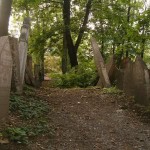 As regular readers of this site you know I’m a big fan of making sure cemetery research is a method used for researching your genealogy and family trees. Below is an example from Southern Graves (see link below for original post) on how we can find our past generations using cemetery search methods.
As regular readers of this site you know I’m a big fan of making sure cemetery research is a method used for researching your genealogy and family trees. Below is an example from Southern Graves (see link below for original post) on how we can find our past generations using cemetery search methods.
The author of the original post writes…
Mrs. Eliza B. R. Mendenhall died almost 160 years ago on December 29, 1848. She was 67 years of age at the time of her death, so her birth year was about 1781. She, along with her infant grandson John Bruce Limehouse, was interred in St. Philip’s Church Cemetery; Charleston, South Carolina.
I love the wording on this stone. In case you cannot read it via the photo, here is a transcription:
This marble marks the spot where repose
the remains of
Mrs. Eliza B. R. Mendenhall,
Who closed her earthly career on the 29th December A.D. 1848,
aged 67 years.
By her side sleeps her infant
grandson
John Bruce Limehouse.
“Thou art gone to the grave, but we will
not deplore thee
whose God was thy ransom, they Guardian
and Guide.
He gave thee, He took thee
and He will restore thee,
and death has no sting for the
Savior hath died.”
This stone is consecrated
to a beloved mother
by her daughter.
(This posting is from Southern Graves. Click the link to view the full article from its original source.)
As you can see from the transcription, there is a wealth of information to help us complete our family trees. Grave stones typically contain extensive records of birth and death dates. They also often cite family members.
By doing the math on age and date of death you can get the date of birth. While not cited here, you sometimes can discover where someone lived from a grave stone as well, which can lead to a local government office and a copy of a birth certificate (which, as you know, will reveal the parents and thus the next generation.)
Don’t overlook cemeteries in our work to build out your genealogy trees. They will save you a ton of time.
…
Where to Next?
Blank Family Tree with Step-by-Step Instructions
…
How to Do a Family Tree – Update on New Resource
December 30, 2008 by Chris
Filed under Blank Family Tree, Family Search The LDS, Genealogy Records 101
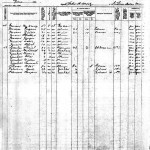 The Family Search website has added over 15 million new indexed records to its Record Search pilot, all from the 1850 and 1870 U.S. Censuses. The records are linked to the digital images of the originals. The new records can be searched for free at FamilySearch.org (Click Search Records, then Record Search pilot).
The Family Search website has added over 15 million new indexed records to its Record Search pilot, all from the 1850 and 1870 U.S. Censuses. The records are linked to the digital images of the originals. The new records can be searched for free at FamilySearch.org (Click Search Records, then Record Search pilot).
Chris
Scotland’s Greatest Story: www.ScotlandsGreatestStory.co.uk
Professional family history research & genealogical problem solving
(This posting is from Scottish Genealogy News and Events. Click the link to view the full article from its original source.)
…
Where to Next?
…
How to Make a Family Tree – The NARA
December 29, 2008 by Chris
Filed under Articles, Getting Started in Genealogy, Introduction to Genealogy, Public Records
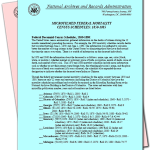
Below is a great article about how to make a family tree through the eyes of a first time visitor to the NARA. In it the author discusses the value of the color guides used to assist researchers with the NARA’s most common records. Make sure you visit the link below to visit the source of the guides online. These resources will surely help you figure out how to make a family tree.
I recently made my first visit to the National Archives and Record Administration (NARA). This is one in a series of articles inspired by that visit to help you make your first visit to the National Archives.
Colored sheet finding aids
National Archives staff have prepared over 160 pages of finding guides to assist researchers with their most common records. These guides are printed on various hues of colored paper. They can be found on a rack in the lobby once you arrive at the Archives.
Not 100% sure the purpose behind the color. These might have been a way to help them stand out or perhaps a coding system. If I learn more I’ll update this post.
While the National Archives has decided not to put these guides online, fortunately, the Mount Vernon Genealogical Society has decided to fill this void. The Mount Vernon Genealogical Society is located in the Washington, DC suburbs where society members are lucky enough to make frequent visits to the National Archives. Some members work there.
Harold McClendon, publicity chair for the society, says,
To make these sheets available to everyone, the Mount Vernon Genealogical Society is placing all of the guides on its web site in PDF format. The guides are organized into the following categories: African Americans, Asian Americans, Census, Citizenship, Civilian Federal Employees, District of Columbia, Early Congressional Private Claims, Immigration, lands, Military, Native American and 1885 State and Territorial Censuses. As new sheets are issued by the National Archives, copies are being added to the web site.
To access these finding aids, go to http://mvgenealogy.org/NARA_Guides.html. McClendon recommends printing the guides related to your research.
As you review the guide, you will then be better able to determine the specific publication to review in search of the desired records. You might even find that the National Archives has publications that you never knew existed.
Thank you, Harold McClendon and the Mount Vernon Genealogical Society for extending this service to the genealogical community.
(This posting is from The Ancestry Insider.)
Great information thanks to the folks at The Ancestry Insider. Use the link above to visit the original post directly and browse their site overall. When trying to figure out how to make a family tree every little bit of information helps.
…
Where to Next?
Blank Family Tree with Step-by-Step Instructions
…
Making A Family Tree – Graveyard Rabbits
December 11, 2008 by Chris
Filed under Articles, Cemetery Searches, Genealogy Cemetery Searches, Genealogy Records 101
 Making a family tree is never an easy undertaking. There are a lot of things to figure out and organize. However, regardless of where you are in the process of making your family tree you’ll find that knowing a bit about researching graveyards will make a huge difference. Today, I’d like to reference the works -as I’ve done often before – of Southern Graves who provides a great little story about the Graveyard Rabbit that I’m sure you’ll enjoy.
Making a family tree is never an easy undertaking. There are a lot of things to figure out and organize. However, regardless of where you are in the process of making your family tree you’ll find that knowing a bit about researching graveyards will make a huge difference. Today, I’d like to reference the works -as I’ve done often before – of Southern Graves who provides a great little story about the Graveyard Rabbit that I’m sure you’ll enjoy.
By way of introduction, the author writes:
My nickname in high school was “squirrel,” but it turns out I am really a rabbit. A Graveyard Rabbit, that is.
If you haven’t noticed the new statement in the heading, I am a charter member of The Association of Graveyard Rabbits. This group was founded by Terry Thornton, and she writes all about the name at her new The Graveyard Rabbit of the Hill Country blog. The short of it is the name came from a poem entitled The Graveyard Rabbit by Frank Lebby Stanton. My favorite lines of the poem are in the very beginning.
In the white moonlight, where the willow waves,
He halfway gallops among the graves –
A tiny ghost in the gloom and gleam,
content to dwell where the dead men dream…
This definitely describes my passion for cemeteries and the histories they share. Let’s break it down:
“In the white moonlight, where the willow waves”
I don’t visit cemeteries at night too much, only because it’s hard to read the stones and take pictures then! However, there are often live willows waving when I visit, as well as many stone willows standing tall.
“He halfway gallops among the graves”
At the risk of sounding silly, if I’m at a Cemetery I’ve never visited before, I often do the same thing! I go from stone to stone, in no kind of pattern, just to get a feel of the place. Plus, an interesting monument from afar gets my interest and I must check it out. I have to make myself at some point stop and systematically go through the graves for proper transcription, photographs, and to begin to get the full history of the Cemetery and those interred.
“A tiny ghost in the gloom and gleam”
I and my visit are but a tiny speck of the whole history of most cemeteries. Especially those that have been around for hundreds of years. There have been many visitors before me, and there will be many after me.
“Content to dwell where the dead men dream”
That statement is a simple fact that applies to me. I am very content walking among the headstones, reading them, photographing them, and learning from them.
I hope you will continue to join me on my journey through the cemeteries of the southern United States at the Southern Graves site and this Southern Graves blog.
Really great stuff, wouldn’t you agree? This is the type of story that makes genealogy and family history research so much fun. Sure, there is the process of hunting down certificates, finding dates and dealing with name changes but then there is also the rich history of the past written in stone. Grave Yard Rabbits are truly a wonderful group who I’m sure we will be revisiting in the future.
(This posting is from Southern Graves.)
…
Where to Next?
…
Family Tree Confusion
December 9, 2008 by Chris
Filed under Articles, Blank Family Tree, Genealogy Reports and Charts, Introduction to Genealogy
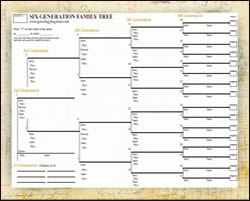
A little while ago we talked about the fact that there are a lot of family tree templates available online. Many of them are extremely fancy and can be very confusing. These decorative templates are great for presentation purposes; however, most people are looking for a simple solution and don’t want to spend endless hours trying to understand this box or that branch. I thought I would take this opportunity to describe my approach here at Genealogy Beginner.
Continue reading “Family Tree Confusion” »
Make a Family Tree with the “Ancestry Toolbar”
December 7, 2008 by Chris
Filed under Articles, Blank Family Tree, Latest News
 There are a lot of great resources out there to help you make a family tree. One of which is the great work done over at Ancestry.com. Recently the Ancestry Insider wrote a great review of how to use Ancestry.com to make a family tree. Specifically, they focus on how you can make a family tree with much more ease than would otherwise be the case by using the browser toolbar.
There are a lot of great resources out there to help you make a family tree. One of which is the great work done over at Ancestry.com. Recently the Ancestry Insider wrote a great review of how to use Ancestry.com to make a family tree. Specifically, they focus on how you can make a family tree with much more ease than would otherwise be the case by using the browser toolbar.
(See bottom of post for original article that I’ve summarized below)
Continue reading “Make a Family Tree with the “Ancestry Toolbar”” »
Giving Your Family Tree for Christmas
December 4, 2008 by Chris
Filed under Blank Family Tree, Family History, Preserving Your Family Tree
 The Ancestry Insider is quickly becoming one of my favorite blog spots, in a post titled “Giving Your Family Tree for Christmas.” There is an amazing wealth of information about publishing a family tree book for yourself or a family member. The best part about the post is that it was inspired by a reader’s question. (See link at the bottom of this article to visit the original post and read about a site visitor who asked a question that started it all.) Here are some highlights from the article:
The Ancestry Insider is quickly becoming one of my favorite blog spots, in a post titled “Giving Your Family Tree for Christmas.” There is an amazing wealth of information about publishing a family tree book for yourself or a family member. The best part about the post is that it was inspired by a reader’s question. (See link at the bottom of this article to visit the original post and read about a site visitor who asked a question that started it all.) Here are some highlights from the article:
Continue reading “Giving Your Family Tree for Christmas” »
Norway 1875 Census
November 25, 2008 by Chris
Filed under Articles, Latest News, Public Records
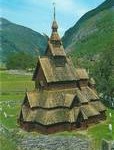
Chris over at Scottish Genealogy News and Events provided an update on the 1875 Norway Census that might be of interest for, “all you Shetland and Orkney folk!” as he puts it. He sites the source of this information as from Family Search (see links below for reference links and the original post):
1875 Norway Census
In the first week of December, we will start indexing the 1875 Norway Census. This will be a large segment of the census for rural areas of Norway, but not the entire census. FamilySearch’s Historical Family Reconstitution unit has joined forces with the University of Tromsø in Norway to complete this project. The university is indexing the census records for the urban areas of Norway.
Pass the word along that anyone interested in Norwegian genealogical research is encouraged to help by volunteering as a FamilySearch indexer.
Completed Projects
The following projects have been completed in the past two weeks. Patrons should be able to search them shortly online at FamilySearch Record Search:
Missouri – 1870 US Census
Tennessee – 1870 US Census
Morelos – 1930 Mexico Census
Alabama – 1920 US Federal Census
Arkansas Marriages II
Alabama – 1850 US Federal Census – General
(This posting is from Scottish Genealogy News and Events.)
…
Where Will You Find Your Ancestors?
Blank Family Tree with Step-by-Step Instructions
…
Commission Recommends $2.15 Million in Grants for Document Editing and Archival Projects

A press release from the National Archives November 20, 2008, published the results of a November meeting of the National Historical Publications and Records Commission (NHPRC).
The recommendations made at the November meeting, were to approve grants in the amount of $2.15 million that would encompass 23 projects across 13 states as well as the District of Columbia
How To Make Family Tree
November 16, 2008 by Chris
Filed under Blank Family Tree
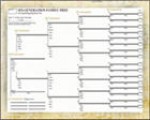 There can be a lot of confusion the fist time you’re trying to figure out how to make a family tree. There are so many sites, resources, templates, and so-called experts that you’re left wondering which way is up. This short article is designed to provide you with a few simple steps that will allow you to get started so you know exactly how to make a family tree. First you need a blank family tree template. You can get one for free at the www.genealogybeginner.com website. Once you download your blank family tree template you’ll need to complete it for yourself and your parents.
There can be a lot of confusion the fist time you’re trying to figure out how to make a family tree. There are so many sites, resources, templates, and so-called experts that you’re left wondering which way is up. This short article is designed to provide you with a few simple steps that will allow you to get started so you know exactly how to make a family tree. First you need a blank family tree template. You can get one for free at the www.genealogybeginner.com website. Once you download your blank family tree template you’ll need to complete it for yourself and your parents.
Just start here. It can be as simple as digging out your own birth certificate and (if appropriate) your marriage certificate, writing do the dates on the blank family tree template, and filing away our certificate copies.
Next you do the same for your parents. You’ll likely need to speak with them about their own parents and to ask for original copies of their birth and marriage certificate so you can make copies and add them to your records.
And that is really what building a family tree is all about. The trick to how to make a family tree is not all that hard (but can be frustrating if you don’t have the basics). It’s a process of identifying the three primary certificates for each of your ancestors (Birth Certificate, Marriage Certificate, and Death Certificate), obtaining copies, and then making notes about who leads to who on a family tree.
Now your family tree search doesn’t need to be limited to just this. While these are the core tasks there is a wealth of other items you can work on and develop to make your tree even richer.
For example, you’ll want to collect any family artifacts you come across like:
- Photos
- Deeds
- Court filings
- Estate records
As well as anything “official” that marks the existence of your family. Some folks make a point to take photos of grave stones or even do gravestone etchings to add to their tree.
With all of these materials in place, you have the basis for a great scrapbook or similar type family heirloom that can be passed down for generations to come. Get an artistic rendering of your official family coat of arms (if you have one), put it on the cover, and you have a wonderful book that defines your legacy.
You see, learning how to make a family tree doesn’t need to be complicated or overly confusing. It simply takes a little understanding of the basics and the will to figure it all out. Check out the resources below if you need a little more assistance:
- Download a Blank Family Tree Template
- Download instructions on How to Complete a Family Tree
- Download a Step-by-Step Genealogy Guide to get you started with your online research.
